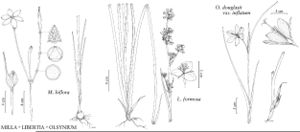Difference between revisions of "Libertia formosa"
Edinburgh New Philos. J. 15: 383. 1833.
FNA>Volume Importer |
FNA>Volume Importer |
||
| Line 32: | Line 32: | ||
-->{{#Taxon: | -->{{#Taxon: | ||
name=Libertia formosa | name=Libertia formosa | ||
| − | |||
|authority=Graham | |authority=Graham | ||
|rank=species | |rank=species | ||
| Line 48: | Line 47: | ||
|publication year=1833 | |publication year=1833 | ||
|special status= | |special status= | ||
| − | |source xml=https://jpend@bitbucket.org/aafc-mbb/fna-data-curation.git/src/ | + | |source xml=https://jpend@bitbucket.org/aafc-mbb/fna-data-curation.git/src/f50eec43f223ca0e34566be0b046453a0960e173/coarse_grained_fna_xml/V26/V26_712.xml |
|genus=Libertia | |genus=Libertia | ||
|species=Libertia formosa | |species=Libertia formosa | ||
Revision as of 20:52, 16 December 2019
Stems 60–125 cm. Leaf blades linear, 15–45 cm × 5–15 mm. Rhipidia fewer than 10-flowered. Tepals white; outer suberect, flushed greenish or brownish abaxially, lanceolate, less than 10 mm; inner spreading, obovate, 12–18 mm; pedicel 6–12 mm. Capsules round to oblong, ca. 1 mm wide. Seeds ca. 25.
Phenology: Flowering spring.
Habitat: Disturbed, urban, coastal areas
Elevation: 0–50 m
Distribution
Calif., South America (Chile).
Discussion
Libertia formosa is cultivated as an ornamental and is an uncommon naturalized escape in California.
Selected References
None.
Lower Taxa
None.
